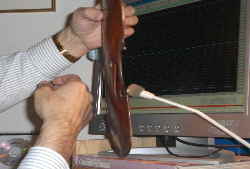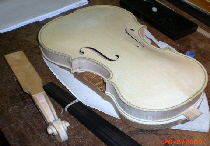|
Here are more details on some of the instruments I have modified:-
A good modern Chinese violin c. 1980,
JTL Medio Fino, Marked “Steiner”.
German “Bench fiddle”, circa 1800 marked ‘Hopf', with a ‘transitional' neck, dating from the early 1800's. I lengthened the neck at its root.
a 15 1/4” (387 mm) Viola, modified to have low plate stiffness factors, and making an outstanding student / orchestral viola!
a German (transitional *) fiddle with a lions-head scroll, also dating from the early 1800's. It had such a low belly Mode 2 that I needed to add 5 cross-braces to raise Mode 2 and also improve the ring/Mode 5 resonances. An outstanding tone - a delight to play.
A violin labelled “John Juzek, Prague”.
A German Stainer copy, a 7/8ths Christian Meisel (1930), and a good Mittenwald, with very dark varnish that once had a severed peg-box.
These violins now have a known, reasonably matched ‘stiffness factors' (which is the ratio of plate stiffness figure to the Reference plate stiffness, as given on this page) on both front and back.
* With a short neck, the kind fitted before ~1820.
|


